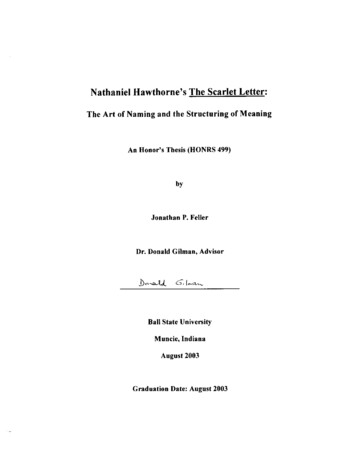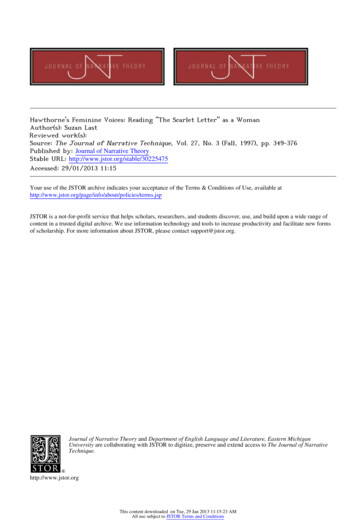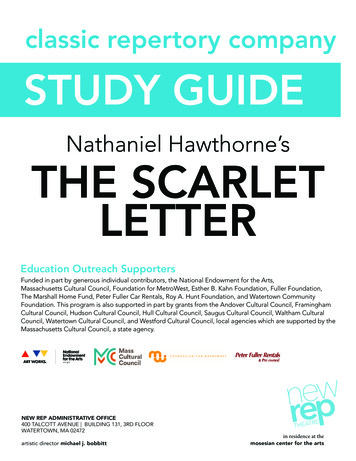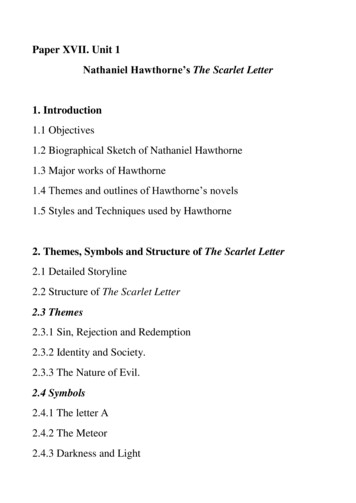
Transcription
Nathaniel Hawthorne's The Scarlet Letter:The Art of Naming and the Structuring of MeaningAn Honor's Thesis (HONRS 499)byJonathan P. FellerDr. Donald Gilman, AdvisorBall State UniversityMuncie, IndianaAugust 2003Graduation Date: August 2003
Acknowledgements- I would like to thank Dr. Gilman for working with me on this project and for hisgreat support throughout my college career.- I would also like to thank my parents for their loyal support and for providing mewith the opportunity to attend college
Table of ContentsAbstract . . . . 2Introduction . . . 3Chapter I: The Historical Framework . . . . . 6Chapter II: Biblical Parallels . 15Chapter III: The Artburian Structure . 29Chapter IV: Metaphorical Meanings . . 34Conclusion . . . . . . . . . . . . . . . . . . . . . . . . 42Bibliography . 44
AbstractNathaniel Hawthorne's The Scarlet Letter (1852) is a meticulously constructednovel that utilizes many thematic and literary devices to deepen its meaning and enrich itstext. One method, which Hawthorne employs to enhance his novel, is onomastics.Onomastics is the study of the origin and forms of names. The novel also forms aframework that derives from formation and use of words that relate to its thematicstructuring. By using characters' names that contain meanings beyond their literalsignificance, Hawthorne enriches the characters' personalities and actions, as well as thenovel's complex artistry.2
IntroductionNathaniel Hawthorne's The Scarlet Letter is a brilliantly crafted American novelthat has become widely studied and criticized. In constructing the novel, Hav.rthomeemployed many literary devices to enhance various aspects of the text. One important,but often under scrutinized device, is onomastics, or the study of the origin and forms ofnames that structure the themes and form of this novel. Hawthorne uses this technique tobring greater depth to his characters and plot.At first glance, a reader of The Scarlet Letter might believe the names Hawthorneused were selected at random. However, with careful analysis of other sources, thereader will fmd Hawthorne's choice of names revealing as they relate to the charactersand text as a whole. Names, coupled with their intertextual meanings, allow the reader tofind parallels, allusions, and historicity, which enrich the text of The Scarlet Letter.Through Hawthorne's use of the multiple meanings inherent in his art of naming,characters in the text are given richer personas, while important relationships and scenesgain greater magnitude.Not all names' meanings and purposes in The Scarlet Letter are readily apparent.Some are subtle and require reflective thought; others are more obvious and require littlecontemplation. In writing this paper, the author hopes to illustrate both the obvious andthe understated uses of names, as well as present new applications as they apply to thetext.Failure to find a comprehensive source for onomastic study of Hawthorne's TheScarlet Letter has fueled the development of this work. A work, such as Kory Watson's3
"A Dictionary of Biblical Allusions in The Scarlet Letter," adequately catalogs many ofHawthorne's biblical references but fails to sufficiently contextualize them. Similarly,Charles Ryskamp's "The New England Sources of The Scarlet Letter" serves to specifythe historical nature of some of Hawthorne's characters hut not others. Metaphoricalmeanings are acknowledged but are often overlooked in favor of writing about moregrand topics. Lastly, no person seems to have recognized the significance of Arthurianlegend in shaping the character of Arthur Dimmesdale. In this work, the author hopes tocontextualize Hawthorne's use of names and their importance in illuminating his novelwith both previously established thoughts, as well a ; new ones.The paper will examine Hawthorne's use of onomastics in The Scarlet Letter byseparating it into four categories that will progress from the most tangible to the mostabstract. The first section will deal with the historical use of onomastics in the text. Thesecond segment will deal with biblical implications within the novel. The third part ofthe work will examine the use of Arthurian legend in Hawthorne's selection of names.Lastly, the work will scrutinize the use of metaphorical ideas used in constructing TheScarlet Letter.This work should prove to be a useful tool in both understanding Hawthorne's useof onomastics in developing his characters and in gaining a deeper understanding andappreciation of his meticulous plot construction. It should also prove to be a usefulcompanion for readers of The Scarlet Letter.This work aims to explain Ha\Nthorne's use of onomastics. Inevitably, it will fallshort of completion and perfection. Additional or alternate critical considerations couldaccount for Hawthorne's selection of names in the text and prove equally reasonable.4
However, this work's purpose is not solely to explain onomastics in The Scarlet Letter. Itaims to spark greater interest, appreciation, and research into a classic, American novel.Furthermore, it intends to develop interest in the other classic works, time periods,people, and ideas that are referenced.5
Chapter 1: The Historical FrameworkOf the four onomastic devices Hawthorne employs, the historical aspect is themost concrete. Hawthorne's use of historical people and places creates a tangible worldfor the novel to take place in. It also allows Hawthorne to give the story a facade offactuality. In examining The Scarlet Letter's use of historical names, the novel is given atime frame and sense of reality. Yet, it also reveals much about Hawthorne, which alsoallows the reader to gain a greater understanding of the writer and his motivation forcrafting the novel.The first historical name that is used in The Scarlet Letter is that of the town ofSalem, Massachusetts. It is the location of the Custom House, the home ofHawthomeand his ancestors, and the town in which the author discovers the "story" of The ScarletLetter. Still, using Salem serves more important purposes. Salem's history comes toshape much of the narrative tone of The Scarlet Letter. Additionally, as horne toHawthorne and his ancestors, Salem serves to more intimately connect him with the storyand its intended direction.Historically, the town of Salem is known for one event above all else - the SalemWitch Trials. The Salem Witch Trials took place in 1692 and have been the subject ofmuch scrutiny. Other witch trials took place throughout the world, but none resulted inthe level of hysteria and persecution that occurred in Salem.Puritans were a superstitious people. They believed only God's grace keptcitizens from turning to witchcraft and other devil's work (Johnson 117). Basically,people had a natural tendency to gravitate towards evil. Additionally, they believed that6
the devil worked most aggressively where he was most dreaded (Johnson 118). Becausethe people of Salem thought of themselves as righteous, God-fearing people, they viewedthemselves as prime targets of the devil. It was partly under these pretenses that theevents of 1692 began.In 1689, Reverence Samuel Parris arrived in Salem. In October of 1691, villagersof Salem stopped paying his salary in an attempt to drive him out ("Chronology . "). Inthe previous sixteen years three other ministers had been driven from Salem under similarcircumstances (Ray). The town had a history ofrejecting ministers, which some scholarshave conjectured fueled Parris and his supporters to create the hysteria in Salem.It is useful to note that Cotton Mather published a oook in 1689 that detailed anoccurrence of witchcraft and accusation (Ray). In 1688, Goody Glover had been accusedand hanged for witchcraft. The children of the Goodwin household had begun exhibitingbizarre behavior and had accused Glover of bewitching them ("Chronology . ").Apparently, Glover had had an argument with one of the elder Goodwin children prior totheir behavior and accusations. That similar behavior and accusations would occur inSalem has led some historians to wonder if the events were related in some way.In January of 1692, Elizabeth Parris, daughter of Samuel, and her cousin AbigailWilliams began exhibiting peculiar behavior that resembled that of the Goodwin children("Chronology . "). Soon after, many other girls, who came from prominent families thatsupported Parris, began behaving similarly. A doctor was called, and he determined thegirls were suffering from witchcraft. Under questioning, the girls identified Tituba.Samuel Parris' Indian servant, as well as Sarah Good and Sarah Osoome("Chronology . "). These actions constituted the beginning of the Salem Witch Trials.7
Throughout the spring and summer of 1692, accusations, interrogations, andexaminations were conducted with the intent of finding witches. One investigator. andlater judge, was John Hathorne. Hathorne was Nathaniel Hawthorne's great-greatgrandfather. And although no evidence proves that John Hathorne ordered anyexecutions. he committed roughly one hundred women and witnessed a minimum ofeighteen executions (Gale 215).In the courts themselves, spectral evidence and identifYing marks were used asevidence. A "witch's teat," which was often a wart, scar, or other skin disfiguration, wasoften used as confirmation (Johnson 121). Spectral evidence, on the other hand,constituted testaments of witches' spirits causing evil or their magic 'Wreaking havoc(Johnson 121). With flimsy proof such as this, the courts speedily convicted witches sothat they might be more quickly removed from Puritan Society.Despite such judiciary charades, public objection did not begin to surface untilprominent figures, such as a former Salem minister, were accused. Still, it was not untilOctober that Governor William Phipps prohibited further arrests ("Chronology . ").Moreover, the process of releasing and pardoning the over one hundred accused lastedinto 1693. Afterwards, various people involved in the trials began expressing guilt andshowing remorse as time passed, but sources say John Hathorne was never remorseful(Johnson 120).Even a brief history of the Salem Witch Trials illustrates how mass hysteria andunjust persecution played roles in the events of 1692. For the Hawthorne's CustomHouse to be located in Salem, this tragic event is evoked. Already standing as a symbol8
of persecution, Salem's presence in "The Custom House" reinforces the notion ofatown's association with overzealous persecution.In The Scarlet Letter, persecution and witchcraft play prominent roles. Hestershows characteristics associated with witches. She is a strong and defiant woman. She isalso treated as an outsider by the townspeople. However, unlike a true witch, Hester isnot in league with the devil. Other than her instance of adultery, Hester proves arighteousness person. Still, there are two characters, Mistress Hibbins and RogerChillingworth, associated with witches who do practice evil.Mistress Hibbins is a knov.rn witch in Boston. At one point, she attempts to lureHester into signing the Black Man's book located in the forest. In the text, it is revealedthat she will be executed for witchcraft a number of years after the novel's actions havetranspired. Mistress Hibbins is the only character in the novel expressly named to be awitch.Nevertheless, Chillingworth too is associated with witches, because he, like awitch, does the devil's work. He plays an important role in relating the events of Salemto the events in The Scarlet Letter through role reversaL In Salem, the accusers wereinitially seen as heroes attempting to purge the world of evil. However, as time passed, itbecame obvious the accusers were the villains. The townspeople had tried and executedmany innocent citizens. They had been viewed as the righteous, but they became thewicked.Like the people of Salem, Chillingworth exhibits role reversal, but he shows it ontwo levels, personally and communally. On a personal level, in the eyes of thetownspeople, Chillingworth's image and role change drastically. Upon fust moving into9
Dimmesdale's home, the townspeople ''were inclined to see a providential hand in RogerChillingworth's so opportune arrival." (p. 84). They believed his skills and knowledgewould help save their ailing minister. Yet, as the novel progresses, the people see himchange drastically. They come to believe he is no longer attempting to heal Dimmesdale.He is now viewed as an agent of the devil, tormenting their pious, young minister.Chillingworth's role reversal is not merely personal though. It comes to representthe location of evil in the community. Originally, the townspeople see evil as being partof the forest's venue. It is the place where Mistress Hibbins meets for her evil rituals.The woods are wild and savage, not civilized like a town. However, as Chillingworthbegins his transformation from revered physician to agent of evil, the townspeoplewonder if the devil, in the guise of Chillingworth, has taken up residence in their toWIl.That the perceived location of the devil moves, from the forest to the town, is significant.The devil is no longer outside the people's realm. He now lives among them, with them.As the people of Salem had seen the devil in others, outside of themselves, so too did thepeople of Boston. But, as the people of Salem carne to realize the devil was part of them,amongst them, as represented by Chillingworth, so too did the people of Boston.What makes Salem further important is its connection to Hawthorne's relative.John Hathorne. Since Nathaniel Hawthorne's ancestor was part of the mass hysteria ofSalem, it relates him personally with the tOWIl. Already at odds with his Puritan heritage,Hawthorne would be distraught to learn of his relative's role in the madness of Salem.John Hathorne served as a persecutor of innocent people in Salem. Because ofthis.Hawthorne identifies with victims in writing The Scarlet Letter, as he relates the story of10
sufferers. Granted, Hester has done wrong. Nonetheless, she atones for her sins,something Hawthorne's relative apparently never did.The actions of another Hathorne, William, serve onomastic purpose for Nathanielalso, as Hester Prynne takes her name partly from history. As Charles Boewe andMurray G. Murphey point out in the records of the Salem Quarterly Court in Novemberof 1668:Hester Craford, for fornication with John Wedg, as she confessed, wasordered to be severely whipped and that security be given to save the townfrom the charge of keeping the child. Mordecaie Craford [her father]bound. The judgment of her being whipped was respitted for a month orsix weeks after the birth of the child, and it was left to the WorshipfulMajor William Hathorne to see it executed on a lecture day. (p.206).This passage mentions a woman named Hester, persecuted for a sexual offense bya man named Hathorne. Though this historical Hester's last name is not Prynne, sheapparently does have a child, is named Hester, does commit a sexual offense, and ispunished. Because Major William Hathorne, one of Hmvthorne's ancestors, persecutesher, it seems likely that her name serves as a possible basis for The Scarlet Letter'sHester. Also, in reference to the Biblical section of this work that deals with Hester, itproves interesting that this woman's father is named Mordecaie.Four other characters in The Scarlet Letter, Governor Winthrop, GovernorBellingham, Reverend Wilson, and Mistress Hibbins, serve important onomasticpurposes. Although they play minimal roles in the story and do little to personallyadvance the plot, they are meaningful. They hold important positions and serve to placethe story in history.Governor John Winthrop's presence in the novel serves primarily to date thenoveL Winthrop was the first Governor of Massachusetts and held office from 1630-34,11
1637-40,1642-44, and 1646-49 (Gale 532). Hawthorne places his death in early May,but his death actually occurred on March 26, 1649 (Gerber 22). Charles Ryskamp pointsout Hawthorne's probable reasons for altering the Governor's time of death. He believesthat Dimmesdale could not have had a night vigil during a cold, Boston March (Gerber22). As one should recall, Dimrnesdale's vigil occurred on the night of Winthrop's death.Also, Ryskamp believes that Hawthorne's plot structure, which was concise andorchestrated, called for the night ofDimmesdale's vigil to be placed within a few weeksof Dimmesdale's confession, which took place on Election Day (Gerber 22). ElectionDay in Boston typically took place in late Mayor early June. Therefore, if Winthrop'sdeath was in early May and Election Day took place a few weeks later, it stands to reasonDimmesdale' scaffold scene took place in late Mayor early June. Though, GovernorWinthrop's role in The Scarlet Letter is very minimal, but his presence serves to date thenovel's theoretical timeline.Governor Richard Bellingham is another character whose name is taken fromhistory. He serves as a symbol of authority. It is he who makes an attempt to have Pearltaken from Hester to be better cared for. The real Bellingham came to Boston in 1634and served as Governor of Massachusetts in 1641, 1654, and from 1665-72 (Gale 31).As stated, Governor Winthrop's death took place in 1649. When Dimmesdaleclimbs the scaffold in the fmal chapter of the novel, it is said Hester had stood in thesame place with Pearl seven years earlier. That would place Hester's public appearanceon the scaffold in June of 1642. Hawthorne names Bellingham as Governor at that time.However, in June of 1642, John Winthrop was governor, not Richard Bellingham (Gerber23). Bellingham would have been out of office one month earlier.12
Once again, Hawthorne's historical accuracy is flawed. However, as before, thereis purpose. Ryskamp suggests that Hawthorne did this to keep "the plot from becomingencumbered with too many minor characters." (Gerber 29). Basically, Hawthorne chosehim to be Governor at the novel's opening so John Winthrop would not be developed as acharacter. Though Bellingham is developed as a character his role remains minor, butstill important.Another historical figure Hawthorne employs is Mistress Anne Hibbins. In thenovel, she is Bellingham's sister and a witch. She is also said to be living with herbrother. Mistress Hibbins serves as a temptress and symbol of evil. She represents whata truly sinful woman is. Because ofthis, she serves as a foil of sorts for Hester. It is saidthat she is executed for witchcraft sometime after the events of The Scarlet Letter areconcluded.Historically, there was a woman named Anne Hibbins who was executed forwitchcraft. She was executed in the June of 1656 (Gerber 29). However, her historicalrelation to Bellingham is not clear-cut. Charles Ryskamp states that there is only onesource, in a footnote by James Savage in the 1825 edition of John Winthrop's History ofNew England, equating Bellingham and Hibbins as siblings (29). It is likely thatHawthorne used this source.Yet, there is still one problem that arises in comparisons between the real AnneHibbins and the fictional one. The historical Anne Hibbins' husband died on July 23,1654 (Gerber 28). In The Scarlet Letter, Hawthorne places Mistress Hibbins as livingwith her brother, Governor Bellingham. while her husband was still alive. Hawthornecould have done this to not add another character. such as Mr. Hibbins. However,13
another reason possesses additional logic. He most likely does this to have "fewer stagedirections and explanations" (Gerber 29). Still, it could be to show evil's infectiousnature on any household or person. Whatever the case, Mistress Hibbins serves as asmall but important character in The Scarlet Letter.One fInal character whose name has historical implications is Reverend JohnWilson. He is a colleague of Arthur Dimmesdale and serves as a symbol of spiritualauthority in the novel. In the text, he is an elder man and is described as being good withchildren. He is presented as a kind and gentle grandfather-like fIgure.According to Cotton Mather, and others, Wilson was compassionate, modest,devout, and liked by everyone (Gerber 29-30). Also, footnotes in the Norton CriticalEdition of The Scarlet Letter state he was Anne Hutchinson's chief religious rival.Compared with other historically based characters of the novel, John Wilson draws onlyminimally from actual events. However, his presence in the novel adds to the historicitythat Hawthorne creates, in the same manner as other historically based characters do.14
Chapter II: Biblical ParallelsThe second way in which Ha\Vthome uses onomastics is biblical. By usingbiblical references in names, Hawthorne gives the story a moral tone and authoritativefeeL He is also able to make the reader connect more readily with characters and theirplights, due primarily to the fact that Hawthorne's audience was principally Christian.Hawthorne's use of biblical references serves to correspondingly and conversely defmecharacters.Hawthorne's most obvious use of biblical reference in shaping characters isthrough Hester Prynne's child, Pearl. "But she named the infant 'Pearl,' as being of greatprice, -purchased with all she had, - her mother's only treasure!" (p. 62). Hm.vthometook this notion from a passage in the Bible that reads, "Again, the kingdom of heaven islike a merchant in search of fme pearls, who, on finding one pearl of great value, wentand sold all that he had and bought it." (Matthew 13:45-46).This Biblical passage can be looked at in two different ways, depending upon theinterpretation. One interpretation views the reader as the merchant. In this case, thereader must sacrifice in order to obtain the pearl, or salvation. Another interpretationholds that Jesus Christ is the merchant, and the pearl of great price is the Christianreligion, a representation of salvation. In this case, Jesus gave all he had so that he couldcreate the true religion, Christianity. Both interpretations are legitimate. Yet, whicheverway the parable is viewed, the merchant gave all he had to obtain the pearl.Having an illicit affair and giving birth to Pearl in a Puritan society cost Hester allshe possessed. Hester no longer had the good name and place she once occupied in15
Boston. However. like the merchant, Hester now has her Pearl of great price, andultimately her Pearl leads to her deliverance. Just ali a Christian must sacrifice to gainsalvation, Hester sacrifices her life and place in society but gains her eventual salvation.And, as Jesus sacrificed to create salvation, Hester sacrifices her life and, in doing so,creates her salvation. In sum, Pearl cost her mother everything but led to her salvation,whichever interpretation of the parable is used.Another reference to the pearl of great price exists in the novel. '''Pearl,' said he,with great solemnity, 'thou must take heed to instruction, that so, in due season, thoumayest wear in thy bosom the pearl of great price . '" (p. 77). In this reference to thepearl of great price, both interpretations prove useful again, though not as potent asHav.1home's first example.If one uses the interpretation ofreader as merchant, the speaker, Mr. John Wilson,is talking of believing in Jesus. In this case, the pearl represents the salvation, Jesus,Pearl must take to heart. If one uses the interpretation of Jesus as merchant, Mr. Wilsonis talking of believing in the church, which is the pearl. As with the passage that explainsPearl's name, both interpretations are justifiable, and both fit the plot.Although no further references to the pearl of great price exist in The ScarletLetter, another reference to pearls is found in the book of Matthew. Matthew 7:6 reads,"'Do not give dogs what is holy; and do not throw your pearls before swine, lest theytrample them underfoot and tum to attack you. '" This passage proves interesting as itapplies to the text because of what occurs in the chapter titled "The Elf-child and theMinister." In brief summation, the chapter involves Hester meeting with GovernorBellingham, Reverend Wilson, Arthur Dimmesdale, and Roger Chillingworth. During16
their talk, it is proposed that Pearl be taken from Hester in order to be raised properly.Hester, in dismay, pleads with Dimmesdale who eloquently intercedes on her behalf.This biblical passage becomes important in shaping and understanding the story,because, as even a cursory reading of The Scarlet Letter will reveal, Hawthorne's view ofPuritans is far from the view they have of themselves. Whereas the Puritans viewthemselves as holy and righteous people, Hawthorne sees them as overzealous andmisguided. If one looks at this passage in Matthew, Pearl would, of course, represent thepearls mentioned in the passage. Also, as applied to "The Elf-child and the Minister,"this passage would paint the Puritans as the swine, which proves noteworthy. Perhaps inreading this passage, Hester is, as occurs in the chapter, not supposed to give up Pearl,because, if she did, the Puritans would ''trample'' her. Considering Hawthorne's view ofthe Puritans, it is not unreasonable to believe that he would describe them inuncomplimentary tenns. Furthermore, one could conjecture that, had Hester given upPearl, her persecution at the Puritans' hands might have been harsher, as the swine willturn to attack the thrower of the pearls.Some critics would write otfMatthew 7:6 as random occurrence. Yet, if onelooks at the passages directly preceding and following Matthew 7:6, the story of TheScarlet Letter is further richened. According to Matthew (7: 1-5),Judge not, that you be not judged. For with judgment you pronounce youwill be judged, and the measure you give will be the measure you get.Why do you see the speck that is in your brother's eye, but do not noticethe log that is in your own eye? Or how can you say to your brother, 'Letme take the speck out of your eye,' when there is the log in your own eye?You hypocrite, first take the log out of your own eye, and then you willsee clearly to take the speck out of your brother's eye.17
Additionally, Matthew (7:7-8) reads, "Ask, and it will be given you; seek, andyou will find; knock, and it will be opened to you. For everyone who asks receives, andhe who seeks fmds. and to him who knocks it will be opened." These passages inMatthew encompass the passage pertaining to pearls and swine.In reading Matthew 7:1-5, one can imply Hawthorne was speaking of thePuritans' judgment of Hester's adultery, which, considering the shortcomings he viewedthem as possessing, seems legitimate. This passage in Matthew speaks of hypocrisy, andHawthorne viewed the Puritans as such, because they judged while having greatproblems of their 0\\111. However, more fittingly, it again calls to mind "The Elf-child andthe Minister," in that Governor Bellingham and other Puritans believed that Pearl couldbe raised better by someone other than Hester. Yet, Governor Bellingham's own sister,Mistress Hibbins, who lives under his own roof, is not a good Puritan but is, in fact, awitch. This points to their hypocrisy as welLFurther. in reading Matthew 7:7-8, one can see how the chapter "The Elf-childand the Minister" still fits the comparisons. This Biblical passage speaks of asking,seeking, and knocking. In all cases, what is sought after is found. Hester, upon hearingBellingham's proposal to take Pearl, pleads with Dimmesdale to change the governor'smind. Dimmesdale's subsequent speech convinces Bellingham, and Hester's plea isgranted. So, in reading Matthew (7:1-8), "The Elf-child and the Minister" gains greatersignificance.Pearl is hardly the only character whose name relates to the Bible. Her mother'sname. Hester Prynne, draws, not only from history, but also derives meaning from theBible. Examining the Book of Esther and relating it to Hester Prynne further elucidates18
The Scarlet Letter's characters and story. Yet, some may not be familiar with the Bookof Esther. Therefore, summary is needed.The Book of Esther takes place in the realm of King Ahasu-e'rus. One day,Ahasu-e'rus sends his eunuchs to summon Queen Vashti. Vashti refuses the king'ssummons and is summarily removed from her position as Queen. The king then has hisservants gather all the beautiful virgins in his lands and has them put in his harem.Esther, niece of Mordecai, was one of these virgins. King Ahasu-e'rus found Esthermore enchanting than all the other virgins and made her Queen Esther, but he did notknow she was a Jew, for Mordecai told her not to reveal that fact.After these events, Ahasu-e'rus appointed Haman as the highest ruler in thekingdom other than himself. All the king's servants would bow before Haman, butMordecai, who sat outside the king's gates, would not because he was a Jew. Haman wasinfuriated by Mordecai's actions. So. he spoke with the king and told him ofa people inhis lands that would not obey his laws. Haman asked to get Ahasu-e'rus to issue a decreethat these people be destroyed. And, the decree was issued.Upon hearing the decree, Mordecai went into mourning. Esther, through the helpof one of the king's eunuchs, relayed messages with Mordecai and became aware of thedecree. However, if anyone went before the king without being summoned, they wouldbe put to death, except for the one to whom the king held out the golden scepter. Esthercalled for a three-day, thr
The first historical name that is used in The Scarlet Letter is that of the town of Salem, Massachusetts. It is the location of the Custom House, the home ofHawthome and his ancestors, and the town in which the author discovers the "story" of The Scarlet Letter. Still, using Salem serves more important purposes. Salem's history comes to










